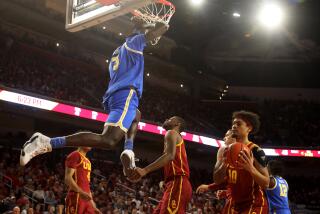Would You Walk Under a Ladder With This Magazine?
- Share via
So it’s payback time, you wily, old Jinx. Finally, you’re plastered on the cover of Sports Illustrated, sprung to life in the form of a lone black cat. The headline: “The Cover that No One Would Pose for: Is the SI Jinx for Real?”
In the magazine’s current issue, an investigative team attempts to deconstruct the Jinx, or the enduring superstition that the cover of Sports Illustrated brings bad luck. Consider the numbers, teases senior writer Alexander Wolff in the Jan. 21 edition. In a six-month investigation, Wolff and a research team looked into almost all of Sports Illustrated’s 2,456 covers, starting with the first one in August 1954. According to their research, within two weeks of a cover appearance, a person or team ran into bad luck about 37% of the time--an injury, a losing streak, a batting slump or worse. (The Jinx, apparently, has left the annual swimsuit cover girls untouched.)
The point being? That Shaquille O’Neal should flee from the magazine’s cover photographers if he hopes to land a free throw in the near future?
The point being that “the myth is out there,” says Wolff in a phone interview. “People talk about it all the time, in e-mail, in sports talk radio. ... I wasn’t so much validating it as [thinking] we’re sitting on top of this story.”
Sports Illustrated could no longer let the so-called cover curse go unchallenged after the Jinx’s apparent wild ride in 2001, Wolff says. Last spring, for instance, the Jinx appeared to frown upon the cover photo of shirtless Boston Red Sox star Nomar Garciaparra, who, a few days after his bare-chested display, suffered a wrist injury that sidelined him for much of the season. Oregon State--the magazine’s preseason top-ranked team--lost its opening game after its star running back appeared on the cover; the team went on to have the worst record of a No. 1 pick. And on and on, leading to a Jinx backlash by year’s end.
Pittsburgh TV and talk-radio stations, for instance, urged their audiences to boycott Sports Illustrated in protest of a cover featuring their beloved Steelers. St. Louis Rams quarterback Kurt Warner--who wears a No. 13 jersey--declined to pose with the black cat on the Jinx cover. (Warner came down with the flu anyway last week before his big divisional playoff game, so we’re not sure what’s going on there.)
Over the years, some well-known sports figures have announced that they don’t want to be on any Sports Illustrated cover. Take former New England Patriots coach Bill Parcells. After a major victory in 1996, he called his daughter, who works at the magazine, and barked: “No cover.”
The Jinx, though famous in its own way, isn’t in the same creeping-out-the-masses league as, say, a 13th-floor elevator stop. “I think it’s just a fun thing for people to talk about,” says Los Angeles Kings spokesman Mike Altieri. People still murmur about what happened to Wayne Gretzy, who was a December cover boy as a King star in 1989. Days later, his streak of consecutive-game assists ended before he could break the NHL record.
In September 2001, Fresno State’s football coaches didn’t think Jinx when quarterback David Carr made the cover. “They don’t worry about the Jinx,” university spokesman Tom Uribes says. “They don’t believe in it.” (Carr, by the way, ended up leading the national statistics in yards passing and touchdown passes.)
According to Wolff’s story, sports psychologists and statisticians have offered a plausible explanation for the Jinx. Experts say that the Jinx illustrates a “regression to the mean.” Translation: A quarterback who is hot enough to make the cover has to go cold at some point. Wolff also quotes a sports psychologist who says the Jinx could represent “a failure to efficiently metabolize heightened expectations.” Translation: Some athletes choke after such high-profile exposure.
The article, while tongue in cheek, also is meant to raise questions on the serious subject of athletes and pressure, Wolff says. What the article doesn’t do is answer the question of whether the Jinx is real.
For decades, the Jinx as been part of the same mystical sports lore that says Reggie Jackson morphed into a batting machine every October, that the Red Sox have been cursed since they traded Babe Ruth to the New York Yankees in 1920. So why throw cold water on what could be a bit of magic, even if it’s black magic?
And if the Jinx does exist and is true to form, it stands a good chance of self-imploding within two weeks.
In the end, Wolff borrows the wisdom of Carl Sagan, quoting from his book “The Demon-Haunted World.” “What’s the harm of a little mystification?” Sagan wrote. “It sure beats boring statistical analyses.”
Stay tuned--no word, yet, on the subject of Sports Illustrated’s next cover....
More to Read
Go beyond the scoreboard
Get the latest on L.A.'s teams in the daily Sports Report newsletter.
You may occasionally receive promotional content from the Los Angeles Times.










